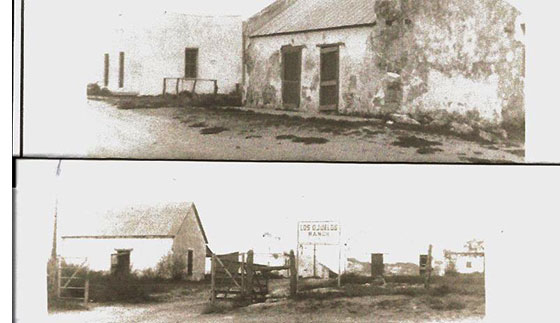Los Ojuelos
The Texas Story Project.

On FM 649, almost three miles south of Mirando City in the southeastern corner of Webb County, sit the remains of Los Ojuelos. A once-thriving 19th century trade town, Ojuelos is now a ghost town, with ruins marking the registered national historic district.
Centuries before Spanish settlers arrived there, American Indians camped on the site, one of the few places in the hot, desert-like surroundings where surface water was dependable. Those springs attracted Eugenio Gutiérrez, who had received a land grant from the king of Spain in 1810. Gutiérrez tried to settle the area, but frequent attacks by nearby American Indians forced him to abandon the site and return to Mexico. In 1835, Gutiérrez's son Isidro attempted to settle near the springs, but he, too, was driven away by American Indians.
Several years later, Dionicio and José María Guerra, grandsons of Eugenio Gutiérrez, left Guerrero, Mexico, with a hand-drawn map to guide them to Los Ojuelos. The goal was to once again locate the ojo de agua that their grandfather had found. The two young men searched for about ten days, but they were unable to find any trace of the springs, so they began the long trip back to Guerrero. When the travelers made camp, José María, being the youngest, was given the responsibility of gathering firewood. It was while collecting wood that José found cow tracks. Early the next morning, the men followed the tracks which eventually lead them to the spring their grandfather had found. There were many other springs as well, which they marked on the map before returning home to Mexico.
In 1850, a company of Texas Rangers under the command of Captain John S. (Rip) Ford established a camp at Los Ojuelos in order to police the growing trade route running through the site from Laredo to Corpus Christi. In 1857, José María Guerra returned to Los Ojuelos where he built a stone enclosure to protect the springs from further raids, an irrigation system, and a chapel. Buildings at Los Ojuelos were built of a hard, white native rock called sillar that was cut into blocks 12 to 14 inches wide and 20 to 30 inches long and joined by an adobe-like mixture. In many ways, the buildings of Los Ojuelos were quite unique. All the outside walls were built at a slight angle so that the entire wall would fall out and away from any occupants if the structure collapsed. The unusually thick walls also made the buildings warm in the winter and cool in the summer. In all, 13 structures were built at Los Ojuelos.
By the 1860s, the Guerra family's Rancho los Ojuelos was producing sheep, wool, cattle, horses, corn, squash, and melons. A quinta, or garden, of about ten acres provided all the vegetables needed during the year. Every six months, the Guerras would make a 45 60-day round trip to the port at Corpus Christi to sell cattle and horses and 15 to 20 carts of corn and wool in exchange for other food products and material for clothing. The ranch was very successful and grew to approximately 20,000 acres. The Guerra's efforts to attract new residents enticed many Mexicans from the Rio Grande Valley to settle there. By 1860, Hacienda de los Ojuelos had a population of about 400 people.
Since Los Ojuelos provided a reliable source of water on the route between the Nueces River and the Rio Grande, the village became a regular stopping point for travelers and wagon trains. During the Civil War, wagonloads of cotton in route to Mexico would lay over for water and rest at the springs.
In 1881, the Texas-Mexican Railway bypassed the town a few miles to the north, and when it connected with the San Antonio and Aransas Pass Railway in 1885, freight headed to and from Laredo was shipped mostly by rail instead of passing through Los Ojuelos. A post office opened in 1894, but by 1904, the population of the settlement had declined to 178. In 1910, Eusebio García, a commissary operator who had lived in Los Ojuelos during the 1880s and had married a Guerra descendant, bought the ranch properties and the town site.
The post office was closed in 1917, and Los Ojuelos remained quiet until O. W. Killam discovered oil nearby in the early 1920s. Killam established Mirando City just north of Los Ojuelos. Although Mirando City and the surrounding area were rich in oil and natural gas, good drinking water was impossible to find, so wells were dug at Los Ojuelos and a pipeline was laid to supply the needed water. The oil boom temporarily expanded the community's population, but quiet returned to Los Ojuelos once drilling at the Mirando City oilfield stopped. From the 1950s through the 1980s, Los Ojuelos remained virtually abandoned. Its buildings were used by local ranchers.
Today, Los Ojeulos is part of a working ranch and is the weekend home of descendants of Eugenio Gutiérrez. It is still the source of water for nearby Mirando City and the surrounding area. Los Ojuelos Historic District was added to the National Register of Historic Places in 1977.
Posted June 30, 2015
Join 44 others and favorite this
TAGGED WITH: Ghost Towns, Hispanic Heritage History Month, Ranching